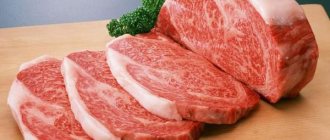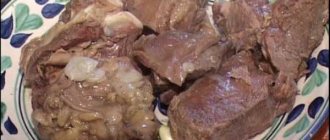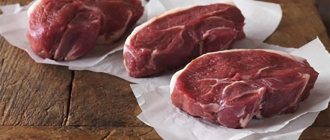Smelly product - get rid of it or leave it?
A repulsive unpleasant odor can be due to various reasons. Most often this happens as a result of:
- storage at high air temperatures;
- being near spoiled food;
- storage in cellophane, with a lack of air access;
- improper feeding or pinning of the animal.
If the smell of a product is in doubt, the product should be inspected, paying attention not only to the aroma, but also to the appearance.
The following points should be of concern:
- unnatural color of the product, not typical for a particular type of meat;
- presence of parasites;
- persistent smell of rot and decay;
- uncharacteristic consistency.
If these signs are present, it is better not to use rotten meat for food, but simply throw it away. But when the smell is not very pleasant, and the product looks normal in appearance, after additional processing it can be used for food.
Is it possible to restore the sense of smell and taste?
In parallel with the decrease in the sense of smell, there is a violation of taste perception. This is a logical process. The aroma of dishes detected by humans enhances the taste and makes it richer. When a person does not perceive the smell of food, he cannot fully appreciate its taste. When olfactory sensitivity is restored, taste perception returns. The ability to distinguish smells and taste can be restored. The earlier you start treatment, the easier it is to do this. It looks like a stroke situation. After a vascular accident in the brain, it is necessary to provide assistance to the person as quickly as possible and begin to restore motor activity as early as possible. It’s the same with coronavirus infection – the faster rehabilitation begins, the better the prognosis. Olfactory neurons have the ability to recover, being renewed approximately once every 40 days. In order for them to earn money faster, they need to be actively engaged.
How to eliminate unpleasant odors at home?
Meat that begins to emit an unpleasant odor should be processed immediately. If there are clearly damaged areas, it is better to cut them off and remove excess fat.
There are two main ways to remove flavor from meat:
How to remove odor by soaking?
Soaking involves placing the meat in a solution for at least an hour. For this they traditionally use:
- wine;
- a low concentration aqueous solution of vinegar (per liter of water - 1 tbsp.);
- saline solution (per liter of water - 2 tbsp.);
- lemon or pomegranate juice.
The product that requires processing is completely immersed in the solution and left for an hour to several hours. This should be followed by a rinse to remove excess soaking solution.
Pickling
You can marinate meat according to several recipes. For these purposes, spices, salt and other ingredients are used. The simplest option is to rub the pulp with a mixture of salt and sugar. The meat remains in this form for 40-60 minutes, after which it is washed in water. If the smell still does not go away, proceed to preparing the marinade.
Most popular recipes:
- Coat the pulp with mustard and keep in a cool place for 1-2 hours.
- Rub the piece with spices (nutmeg, basil, black pepper, thyme, rosemary, etc.).
- Rub the meat with chopped garlic and chopped onion.
- Aging in soy sauce with added spices.
Time frame for restoring the sense of smell after coronavirus
The return of the ability to distinguish odors is a favorable sign of recovery. The recovery time for the sense of smell after coronavirus can vary from 8-14 days to 1-3 months after resolution of the disease. Unfortunately, in rare cases, irreversible damage is possible. This situation is associated with a history of chronic pathologies of the paranasal sinuses, neurological diseases, injuries or surgical interventions on the brain.
Restoring the functioning of taste buds
The timing of the restoration of taste after coronavirus most often coincides with the time of “return of smell” or shifts by another 1-2 weeks from the beginning of regression of symptoms. However, in severe cases, the taste may return within six months, and sometimes not completely.
Important!
The article is for informational purposes only. Specialists of the RC “Motion Laboratory”, as part of the “Rehabilitation after Coronavirus” program, accept patients with post-Covid syndrome only if the result of PCR testing is negative. The program does not provide therapy to restore the sense of smell.
The main objectives of the program: improving the functioning of the cardiovascular, respiratory, nervous systems, musculoskeletal system, increasing the vital capacity of the lungs, increasing endurance, performance, stabilizing the psycho-emotional state, normalizing sleep, returning to an active lifestyle and sports.
How to remove during cooking?
To minimize the unpleasant odor that may appear during cooking, the meat must be pre-soaked. Vegetables baked in a dry frying pan will help solve the problem. They, like spices, can be added to the broth after boiling.
Bay leaf flavors the broth well . But you don’t need a lot of it - just one is enough for a three-liter pan.
You should also collect the foam that appears in a timely manner. If the smell is strong, drain the first broth after boiling, add fresh water and continue cooking.
On what day can the sense of smell disappear during coronavirus infection?
Most often, anosmia develops 4-6 days from the onset of the disease. However, it has significant differences from olfactory dysfunction caused by a cold or acute respiratory viral infection. With other viral lesions of the respiratory tract, the nose is always blocked, sneezing, runny nose, sore throat, partial change in taste sensations, body aches, chills, and fever up to 38-39°C appear. With coronavirus, loss of smell is the only symptom. In more severe cases, anosmia causes nasal congestion and dryness of the respiratory tract. A dry, unproductive cough, hyperthermia (up to 39-40°C), distortion or complete loss of taste, weakness, headache, and difficulty breathing appear.
Not very fresh, long-sitting, suffocated meat: what to cook?
Not quite fresh meat that can still be used for food must be pre-prepared.
To do this, it is soaked or pickled. From recipes, it is preferable to choose those that are prepared with a large number of spices . It can be Caucasian, Indian, Chinese or other cuisine.
A prerequisite for preparing a not very fresh product is high-quality heat treatment.
Diagnostics
Early diagnosis of Botulism is extremely important. Botulism often wears “masks”, hiding under other diseases: Guillain-Barré syndrome, encephalitis, polio, Lambert-Eaton syndrome, meningitis. This significantly complicates diagnosis [5], [9–11], [14], [15].
In search of botulinum toxin, antibodies to the pathogen or DNA of the pathogen, material (urine, feces, vomit or blood) is collected from the patient and clinical and laboratory tests are carried out. An important method for confirming botulism is to demonstrate the effect of the toxin in mice. To do this, bacteria are isolated from patient material and injected into mice. In the presence of botulinum toxins, mice develop paralysis within 48 hours, which can be suppressed by administration of toxoid [12].
Features of removing amber for various types of meat
Different types of meat have their own characteristics in cooking and preparing the product for processing. For some species, a slight odor is natural and does not indicate spoilage.
Duck initially has a specific smell . To deal with it, soaking is used. You can use regular cold water. After this, the duck is wiped dry and rubbed with herbs. It is better to cook duck with spices that will overpower the aroma and make the dish delicious.
Beef
Beef lends itself well to marinating and soaking. You can start by soaking not too large pieces in a solution of vinegar and salt. After this, the meat is washed and, depending on the severity of the smell, marinated.
Fragrant rabbit
If a rabbit is not slaughtered correctly or has not been fed according to standards, its meat will have a specific odor and taste. There are several methods specifically for this type of meat.
- Soak in cold water for 10-12 hours. If you have time, it is best to do just that, gaining freedom in further use. The meat will be absolutely neutral and ready for any processing method.
- Marinate. For this purpose, you can use kefir, olives with tomatoes, a mixture of wine, sour cream and juniper. The meat will be ready within an hour and will acquire the flavor of the spices and bases used in the marinade.
Advice
If the rabbit is old enough, its meat may be tough. Using a kefir marinade will help soften it.
Recommendations
Advice from experts will help in resolving the issue:
- It is easier to determine freshness by chilled meat than by frozen meat.
- When purchasing, you can determine the freshness of meat by pressing on the flesh. If the fibers straighten quickly, the product is fresh.
- The color of the meat should match its type. Too dark or unevenly colored may indicate that the product is stale.
- You can only store a meat product in the refrigerator in cellophane for a short time, since without access to oxygen it will dry out.
- Before freezing meat, remove as much air as possible from the bag.
- If all conditions are met, the product cannot be stored in the refrigerator for more than 2 days.
- Soaking and marinating should not last less than 1-2 hours.
- After soaking, the meat must be rinsed before cooking.
It is not advisable to purchase meat of which you are not sure of its quality.
Restoring the sense of smell after coronavirus
Specialists of the rehabilitation center “Movement Laboratory” develop special recovery programs for each patient
Initial consultation with a rehabilitation specialist
One of the characteristic symptoms of coronavirus infection is loss of smell. Olfactory dysfunction, considered the earliest and most important prognostic factor of the disease, differs significantly from anosmia caused by other infectious pathogens. For some patients it can have very serious psychological consequences. Therefore, restoring the sense of smell after coronavirus becomes the cornerstone of modern medicine.
CMRT specialist says
Publication date: December 01, 2022
Review date: December 24, 2022
The content of the article
The problem is storage in cellophane
Polyethylene bags contain recycled cellulose, which gives products a strong “chemical” smell.
Beef in cellophane is saturated with the odors of other food products in the refrigerator
It is not recommended to store lamb, beef and pork in cellophane because the product begins to become damp and moldy. Before you put the meat in a plastic bag, you need to wrap it in thin paper.
Beef in cellophane is saturated with the odors of other food products in the refrigerator.
To eliminate extraneous aromas, you should use these tips for soaking meat:
- Soak any meat in a mixture made from salt and birch charcoal for 3-4 hours. After this procedure, the unpleasant “smell” will disappear.
- Rub the beef with spicy spices (basil, oregano, cardamom) and leave for 60 minutes.
- Soak chicken in lemon juice or chamomile decoction (add 1 tbsp dried flowers to 1 liter of water).
Possible reasons
There are a number of reasons why meat loses its natural flavor. In some cases it was not there in the first place. This happens when meat:
- completely rotten;
- a little spoiled;
- it was in the refrigerator in a plastic bag and developed an unpleasant odor;
- a rabbit that was not fed properly or was slaughtered incorrectly;
- boar pork;
- lamb with a peculiar smell.
A spoiled product in the form of rotten meat will have to be mercilessly thrown away, since its consumption, even after heat treatment, will lead to poisoning of the body. In other cases, you can successfully remove this flaw and prepare decent food.
Why does meat have a “smell”?
The loss of the natural aroma of meat products occurs in several cases. “Smell” appears due to spoiled products lying next to the meat, as well as due to improper feeding and slaughter of the animal.
Storing in plastic bags leads to a lack of oxygen, causing the meat to “suffocate.”
Pieces of flesh from an uncastrated boar or ram initially have a distinctive odor, but this does not mean that they are unsuitable for consumption.
You just need to soak the product in a marinade or roll it in herbs.
If chicken has an unpleasant sour aroma, and mucus is noticed on its surface, it is necessary to cut off the skin emitting the smell with a knife. If the stench cannot be eliminated, then eating meat is strictly prohibited.
Possible complications
Read also: Watermelon poisoning in humans
Food poisoning is dangerous because it can lead to dehydration. With rapid fluid loss, acute renal failure or hypovolemic shock may develop. In children of the first year of life, dehydration develops at lightning speed, and therefore they are in the greatest danger.
Botulism in case of poisoning from pork, beef or other undercooked, poorly preserved or smoked meat is dangerous if help is not provided in a timely manner. Respiratory cessation or choking on saliva or vomit is possible, which will lead to the death of the patient. Rehabilitation after infection is long. Due to shallow, weak breathing, complications often develop in the form of pneumonia, bronchitis, tracheobronchitis, and atelectasis, which greatly slows down the healing process.
Have you ever had meat poisoning?
- Yes it was
- No, it wasn't
- There are now signs of intoxication
- I do not eat meat
ResultsPoll Options are limited because JavaScript is disabled in your browser.
- Yes, there were 41%, 184 votes 184 votes 41% 184 votes - 41% of all votes
- No, it wasn’t 34%, 151 votes 151 votes 34% 151 votes - 34% of all votes
- Now there are signs of intoxication 22%, 96 votes 96 votes 22% 96 votes - 22% of all votes
- I don't eat meat 3%, 13 votes 13 votes 3% 13 votes - 3% of all votes
Total votes: 444 08/05/2017 You or from your IP have already voted. Vote
- Yes it was
- No, it wasn't
- There are now signs of intoxication
- I do not eat meat
You or from your IP have already voted. results
Options for removing odor from meat
Improper storage of the product leads to the fact that even freshly purchased meat begins to emit a repulsive stench. At the initial stage, it is still possible to eat such products, but only after the stench has been eliminated.
It is not advisable to store any meat for a very long time. Lying in a refrigeration unit for a long time leads to the appearance of a rotten smell. To eliminate it, use potassium permanganate, dried chamomile flowers, salt and wine.
You can eliminate unwanted aroma with basil, tarragon and red wine.
Sequencing:
- Pour wine into an aluminum container, add tarragon and basil, then put pieces of meat into the container.
- Keep the product in wine for 60 minutes, then start preparing meat dishes.
Note! After soaking the meat pieces in wine, they are fried for piquancy and better taste.
Potassium permangantsovka
With the help of manganese they fight any stench.
After soaking the meat pieces in wine, they are fried for piquancy and better taste.
Potassium permanganate is popular among unscrupulous traders who sell spoiled beef or pork. This product helps improve the appearance, aroma and color of the product.
To eliminate the unpleasant “smell” you need to do the following:
- Dissolve 5 g of potassium permanganate in 2 liters of water. The solution should be pale pink.
- Soak spoiled pieces of pulp in liquid for 2 hours.
- Remove beef from solution and rinse thoroughly in cold water.
The unpleasant stench will disappear after this procedure. The product can be safely consumed.
Chamomile decoction
To get rid of meat odor using chamomile, you need to:
- Brew a decoction of the dried inflorescences of the plant and cool it.
- Strain the chamomile infusion through a fine sieve or cheesecloth and place the pieces of meat into it.
- Add 2 tsp. sugar and leave it like that for half an hour.
- Rinse the product in salted water.
Lose weight easily (results in 25 days)
Why persistent dieting DOES NOT BRING visible results, but only leads to frustration and depression, and how to still lose weight in order to:
- Get your husband's attention back or find a new man.
- Feel the envious glances of friends and colleagues again.
- Believe in yourself, feel slim and desired.
- Don't be shy to go to the cinema or to a cafe with your friends.
- They are not shy about posting photos from vacation or with children on social networks.
Burn fat specifically in problem areas
During storage, various processes can occur in meat, which lead to significant changes leading to loss of freshness, nutritional and culinary properties. Typically, such changes occur due to the activity of microorganisms entering the meat. Contamination of meat with microorganisms can be carried out intravitally in the case of slaughter of infected and overworked animals, as well as in violation of the conditions of pre-slaughter holding. Post-mortem contamination of meat during cutting, storage and transportation of carcasses is considered the most typical.
Meat licking
It occurs quite often and is considered a harbinger of putrefactive processes. The reason for the occurrence of this process is a violation of storage conditions when temperature and air humidity change in the places where meat is stored. Slitting of meat is caused by mucus-forming bacteria that are resistant to low temperatures and develop well even at a temperature of 0°C.
They are not dangerous to humans. More often, mucus processes can be observed throughout the carcass or in the place where it is contaminated with blood, in the folds of the surface of the meat (neck, flank, shoulder blade, inner sides of the chest and abdominal cavities). The surface of the meat becomes sticky, gray-white in color, often with a nasty sourish-musty odor.
Mucus-forming microorganisms do not penetrate into the deep layers of meat, and therefore the defect affects only its upper layer. But such meat cannot be stored; it must be washed with water or a 15-20% salt solution, followed by drying and ventilation. Places where mucus or odor is particularly pronounced are thoroughly cleaned. The meat should be used quickly, preferably for preparing first courses, or processed when exposed to high temperatures.
The process of sliming should be distinguished from sliming, which accompanies the initial stage of decay. This mucus formation is caused by other microflora, which causes the breakdown of the tissues that make up the meat. In such cases, a musty, putrid or rancid odor appears.
Meat molding
Occurs due to the development of mold fungi on its surface. Molds can thrive in the acidic environment that appears during the ripening process of meat, low humidity (75%) and sub-zero temperatures. The development of mold is largely promoted by high humidity of meat and insufficient air ventilation in storage areas. Molds develop rather slowly, which is why the defect appears when meat is stored for a long time.
Colonies of various shapes and colors appear on the surface: white, gray-green, dark green, black, round, velvety, etc. Mold is also accompanied by the breakdown of proteins with the appearance of alkaline products, and thus conditions are created for the development of putrefactive microflora. The breakdown of fats leads to a change in the appearance of the meat and the formation of a musty smell.
If the meat is infected with mold only on the surface, then it is washed with a 20-25% solution of table salt or 3-5% acetic acid, followed by ventilation and drying.
If mold penetrates shallowly into the meat (0.5-1 cm), the infected parts should be carefully cleaned and washed with strong brine. Meat that is severely affected or has a musty smell that does not disappear when it is aired should not be used for food.
Souring of meat
Causes acid-forming bacteria if meat is poorly bled, wet, or stored at high enough temperatures. The meat becomes soft, gray in color and has an unpleasant sour smell. Such meat usually develops mold and mucus-forming bacteria. Such meat must be washed with water.
We suggest you read: How to remove scratches on floors and wooden furniture
tanning meat
This type of spoilage that occurs in the first hours after the slaughter of an animal due to improper storage of meat in a stuffy room at temperatures above 18-20°C, as well as when cooling or freezing conditions are violated. Tanning is a common occurrence when fresh meat, particularly from well-nourished animals, is placed in a tight, airtight container. A tan appears as a result of the activity of enzymes without any participation of microflora.
Distinctive signs of tanning: fading of the muscles, its color is brown-red or grayish-greenish, a strong sour odor reminiscent of the contents of the gastrointestinal tract of cattle, flabby consistency of the infected area.
Meat with signs of tanning is cut into small pieces and aired. Green areas are thoroughly cleaned. If signs of tanning do not disappear within 24 hours, the meat should not be used for food.
Rotting
A very complex process of protein breakdown, caused by the vital activity of various putrefactive microorganisms, the development of which occurs under certain conditions: high temperature, high humidity and access to oxygen. Rotting is accompanied by the appearance and accumulation of various intermediate and final decomposition products, among which there are poisonous, bad-smelling, volatile and many other substances.
The less sanitary and hygienic conditions are observed, the more microbiological contamination of meat. Bacteria penetrate deep into the meat through connective tissue layers. Too high a content of connective tissue and blood in meat leads to rapid spoilage. Such meat is usually obtained from poorly nourished, infected or tired animals before slaughter.
Meat in the early stages of spoilage is more dangerous than in the late stages. This is largely due to the accumulation of putrefactive substances such as amines and bacterial toxins, which, as the decay process deepens, turn into much less toxic. At the same time, fermentation of carbohydrates and oxidation of fats occurs. Rotting, in turn, is accompanied by a change in the structure of tissues and physical and chemical parameters of meat.
When determining the degree of freshness of meat, its appearance, consistency, color and smell are determined, as well as the quality of the broth during cooking (cooking test). The cooking test helps to clearly recognize the smell of meat. Fresh meat has a clear broth (without flakes) and a pleasant, aromatic smell. Meat in the initial stages of spoilage produces a cloudy, inodorous broth with a putrid odor.
Fresh meat, as a rule, has a dry, rustling dry crust, a distinctive color for this type of animal. The consistency is quite elastic, the hole formed when pressed with a finger is leveled out quickly, the smell is specific, slightly sour.
In the initial stage of spoilage, the drying crust immediately disappears, the surface of the meat is covered in places with mucus, and over time it becomes wet and sticky, the color is darker or dirty gray. The consistency is soft, the hole is leveled out with some delay, the smell is sour, stale, musty or slightly putrid in the surface layers and normal in the deep ones.
The fat becomes dull in color, sticks to the fingers, the tendons are softened, gray in color. In spoiled meat, these indicators are enhanced. Meat in the initial stage of deterioration can be used to prepare soups after cleaning areas infected with rotting and washing the meat with a 1-2% solution of acetic acid or a 0.2-0.5% solution of potassium permanganate.
It is worth remembering that the effect of acetic acid causes meat to acquire a gray tint, and potassium permanganate causes a metallic taste. Spoiled meat is immediately destroyed.
It’s a shame when meat purchased in a store or market begins to emit an unpleasant aroma when warm. Most likely, you bought a stale piece, and perhaps the smell is a feature of the meat, for example, if the slaughtered individual was sexually mature or was kept on biological fattening. You can get rid of the smell, but first check the freshness of the product.
The meat should smell! The complete absence of odor is a reason to refuse the purchase: most likely, the product has been washed and treated with chemical compounds due to the appearance of signs of rotting.
Uncastrated boar meat: how to get rid of the smell?
The stench of boar meat that has not been castrated can be eliminated by soaking and freezing.
A common reason for the smell of pork pulp is that the animal was not neutered.
For soaking you need:
- Take a pan with warm salted boiled water and add 5 tbsp. l. vinegar essence (per 1 liter of water).
- Soak the pork in milk for 6 hours, changing it every 2 hours.
The method of freezing unwanted “flavor” is effective due to the effect of low temperature. The boar pulp should be frozen for 3 days at a temperature not lower than -25 degrees Celsius.
Before freezing, the product is soaked in milk or vinegar solution.
First Aid Basics
What to do in case of poisoning? First of all, all efforts should be aimed at removing toxins from the victim’s body.
Read also: Salmonellosis, what kind of disease is it?
The person undergoes gastric lavage. He is forced to drink several glasses of water, and then, by pressing on the area of the root of the tongue, he is induced to vomit. The manipulation is repeated until the wash waters become clean.
If a person is unconscious, then washing is not carried out! The procedure is also not recommended for children.
First aid also consists of taking adsorbent drugs. Enterosgel, Filtrum STI, activated carbon are suitable. With their help, you can achieve the binding of toxins and their safe removal from the body.
The person who has been poisoned should drink plenty of fluids to prevent symptoms of dehydration. A solution of Regidron or WHO powder is recommended, but ordinary water in small portions with an interval of 10-15 minutes is also suitable.
How to remove bad odor from chicken
Before you get rid of the foul odor, you need to make sure the chicken is fresh and ready to eat. High-quality chicken pulp has a pink structure and a white tint to the fat layer.
To get rid of an unpleasant aroma, they resort to using simple and accessible techniques:
- You can “mask” the stench with chopped onions and garlic cloves. Peeled garlic is crushed in a garlic press, and the onion is grated. Rub the chicken with the prepared mixture and leave for 30 minutes in a cool room.
- If there is no time to soak the chicken, it is prepared using available means - salt and wheat flour. The two components are mixed and the mixture is rubbed onto the meat pieces. Flour absorbs unpleasant aroma, and salt cleanses the skin of the chicken carcass.
The “odor” is combated by marinating chicken. You need to take vegetable oil, wine or vinegar, add basil and place the product in this solution for 30 minutes. Wash with cold water and start cooking.
Competition “Bio/Mol/Text”-2020/2021
This work was published in the nomination “Visually about the beloved” of the competition “Bio/Mol/Text”-2020/2021.
The general partner of the competition is the annual biotechnology conference BiotechClub, organized by the international innovative biotechnology company BIOCAD.
The sponsor of the competition is SkyGen: a leading distributor of life science products on the Russian market.
Competition sponsor: the largest supplier of equipment, reagents and consumables for biological research and production.
"Book" sponsor of the competition - "Alpina Non-Fiction"
The poster is also available in pdf format.
How to get rid of lamb smell?
In order not to spoil the dish with stench, the meat is properly processed. Excess fat, which gives off flavor, is removed from the lamb. Using available seasonings, grate the pulp and place in the refrigerator for 3 hours.
Marinating can be replaced by boiling lamb in broth, adding spices, carrots and onions. For 2 hours you need to soak the meat in water with the addition of garlic, salt, mustard and pepper.
Meat pieces are poured with water, boiled, then all the broth is drained. The procedure is repeated 3 times. Along with hot water, the aroma will disappear.
How long to cook beef
To make the meat soft, take a piece no larger than two kilograms. The smaller the piece, the less time you will need to cook it.
How long to cook beef until done?
How long to cook beef in pieces
If you decide to save a little time and cook the beef in pieces at once, rest assured that the meat will be ready in 25-40 minutes , depending on what pieces you cut to size. The cooking algorithm is described above, do not forget to remove the foam and add salt.
How long to cook beef on the bone and without the bone
If we cook beef on the bone, the broth turns out tasty, rich, and then it can be used to prepare the first course. Cooking beef on the bone is enough for 1.5 - 2 hours , based on the size of the piece, check the readiness of the dish with a fork or knife. The cooking time for boneless is described above - from 2 to 3 hours , if it is a smaller piece or several small pieces, then 30-40 minutes is enough.
How long to cook beef for soup
For soup, meat is usually boiled on the bones, ribs or other parts. It is enough to cook on the bone for 1.5 - 2 hours (also depends on the size), removing the foam immediately after boiling, otherwise the foam flakes will settle to the bottom of the pan, and the broth will not turn out clear. A gentleman's set of spices that will highlight the taste of beef - salt, peppercorns and bay leaf.
How long to cook beef for a child
Usually mothers prefer to buy their children veal rather than beef. The meat is much more tender and cooks faster. How to cook beef for a child and how long it takes.
- If the child is small, we cook boneless beef, we also need filtered water, carrots and onions. If the child is over a year old, you can add a little salt.
- Cooking time for meat depends on the size of the selected piece. 100 grams of meat is cooked for 30 minutes , 100 grams of minced meat - 10 minutes, for a piece on the bone it takes an hour. So, we cut up a piece of meat, fill it with filtered water and you can put it on the fire.
- When the water boils, be sure to remove the foam, cook for literally 10 minutes, and then drain the primary broth. Children under one year old should not be given broth. Fill with filtered water again and set to boil.
- If we cook meat on the bone for an adult child, 30 minutes before it’s ready, throw in the peeled onion and carrot pieces. Check readiness with a knife or fork. Boiled meat should be very soft. If you doubt its readiness, cut off a piece, look at the cut, and you can try it.
- You can serve beef to your child in different forms - puree it in a blender, cut it into pieces and serve with a side dish.
Therapeutic Uses of BoNT
Despite all the dangerous effects on the human body, BoNT is widely used in medicine and cosmetology. Doctors use BoNT's ability to cause flaccid paralysis.
In cosmetology, BoNT is known as Botox. Botox is a purified form of botulinum toxin A that is often used to treat wrinkles. BoNT blocks the signals that the brain sends to the facial muscles, and wrinkles simply stop appearing. In addition, Botox injections can be useful in combating excessive underarm sweating.
In medicine, BoNT helps eliminate neurological disorders - dystonia, spasticity, strabismus and others, as well as treat migraines and overactive bladder [8].
Christina V. and Toma P. worked on writing the text. Ekaterina B. created these wonderful illustrations, for which special thanks to her! The topic of the article was conceived by Christina V. Editing the text, drawings and creating posters was also done by Christina V. and Toma P.











